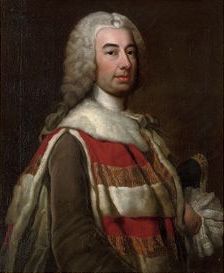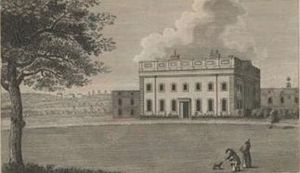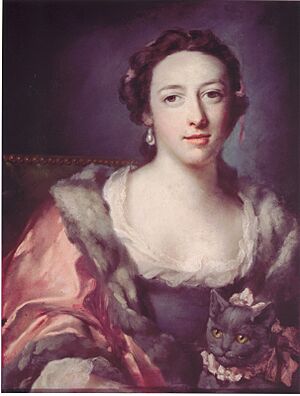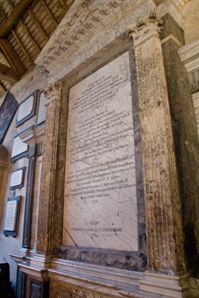Robert Knight, 1st Earl of Catherlough facts for kids
Robert Knight, 1st Earl of Catherlough, also known as KB, lived from 1702 to 1772. He was a British politician who served as a Member of Parliament (MP) for several areas. These included Great Grimsby, Castle Rising, and Milborne Port.
Robert Knight received several important titles during his life. He became Baron Luxborough in 1745. Later, in 1763, he was made Viscount Barrells and then the Earl of Catherlough. All these titles were part of the peerage of Ireland, which means they were noble titles in Ireland. His wife, Henrietta Lady Luxborough, became famous for her writing and for being a pioneer in designing beautiful gardens.
Contents
Robert Knight's Family Background
Robert Knight, the 1st Earl, was born on December 17, 1702. He was the only son of Robert Knight (1675–1744) and his first wife, Martha Powell. His father became well-known for a scandal involving the South Sea Company.
Robert Knight senior was a cashier for the South Sea Company. This company was involved in a huge financial crisis called the "South Sea Bubble." His father ran away to France with a lot of money and started a banking business in Paris. He had built Luxborough House in Chigwell, Essex, after buying the land there. However, the South Sea Company took over his properties. They sold Luxborough House to Sir Joseph Eyles.
Robert Knight senior had one other child, a daughter named Margaretta. She married Morgan Vane, the son of the Baron Barnard. You can see a monument for Robert Knight senior in St Peter's Church, Wootton Wawen, in Warwickshire.
Robert Knight's Education
Robert Knight went to Wadham College, Oxford, a famous university, in 1719. He also began studying law at the Inner Temple in the same year.
Robert Knight's Career and Titles
In February 1721, Robert Knight was with his father when he fled to Brabant. After returning to England, he married Henrietta St John on June 10, 1727. Henrietta was the daughter of Henry St John, 1st Viscount St John. Her mother was Angelica Pelissary, whose father was a treasurer for King Louis XIV. This meant Henrietta was the half-sister of the very influential Henry St John, 1st Viscount Bolingbroke.
In 1730, Robert Knight bought Barrells Hall in Warwickshire. This was an old family home of the Knight family. He became a Member of Parliament for Great Grimsby in 1734.
His marriage faced difficulties before 1736. After this, and when Bolingbroke went back to France, Robert Knight became less involved in political parties. He kept his seat in Parliament until 1741. In 1740, his father bought Luxborough House back. Robert Knight inherited it in 1744.
On August 8, 1745, he was given the title Baron Luxborough. In 1747, he won a seat in Parliament for Castle Rising, Norfolk, and held it until 1754. In 1749, he sold Luxborough estate to James Crokatt, a merchant.
In March 1761, he became the Recorder (a type of judge) of Grimsby. In 1761, his son Henry became an MP for Great Grimsby. When Henry sadly died in August 1762, Robert Knight decided to run for the seat himself. He won without anyone opposing him and stayed in Parliament until 1768. He said he wanted to be in Parliament because it might be "an amusement" during his sad time.
He supported the Earl of Bute, who was Prime Minister from 1762 to 1763. On May 14, 1763, he received even higher titles. He became Viscount Barrells and Earl of Catherlough. These titles were given to him by George Grenville, the next Prime Minister.
In 1770, he successfully ran for Parliament again for Milborne Port, Somerset. He held this seat until he died. He was also made a Knight of the Bath (KB) on May 18, 1770.
Robert Knight's First Marriage
Robert Knight sent his first wife, Henrietta St John, to live at Barrells Hall in 1736. This was because she had been involved in a romantic situation. Henrietta, Lady Luxborough, was known for her beautiful garden designs. She was one of the first to create a ferme ornée, which is a decorative farm. She is also credited with using the word "shrubbery" for the first time.
Henrietta was part of the Warwickshire Coterie, a group of poet friends. This group included the poet William Shenstone, who also designed a ferme ornée at The Leasowes.
Robert Knight's Second Marriage
After Henrietta died in 1756, Robert Knight began living at Barrells. He married Lady le Quesne on June 18, 1756. She was the widow of Sir John le Quesne, a London Alderman. Her maiden name was Mary Knight, and she came from Hampshire. She brought a large amount of money, £20,000, to her first marriage.
Sir John Le Quesne was a Huguenot, a French Protestant. He was a director of the French Hospital. He also served as a sheriff for the City of London in 1739. A beautiful silver tea kettle was made for Sir John and Mary's wedding in 1738 by the silversmith Paul de Lamerie. This kettle is now in the collection of the Courtauld Institute in London.
Robert Knight had several children with Jane Davies, who was a tenant on his farm. He could not marry Jane because his second wife, Lady Le Quesne, did not agree to a divorce. Mary died in 1795.
Death and Burial
The Earl of Catherlough died on March 30, 1772, when he was 69 years old. He was buried in Ullenhall. His will was officially approved on April 10, 1772. All his noble titles ended when he died because his son, Henry Knight, had passed away before him.
Robert Knight's Children
Legitimate Children
- Hon. Henry Knight (1728–1762). Henry was a Member of Parliament for Grimsby from 1761 until his death on August 15, 1762. He was 34 years old. He married Frances Heath in 1750, but they did not have any children. He was buried in Ullenhall.
- Henrietta Knight (1729–1763). Robert Knight's only daughter, Henrietta, also died before him. She first married Charles Wymondsold. After they divorced in 1754, Henrietta married Hon. Josiah Child. Josiah was an officer in the Royal Navy. She had a son named Josiah shortly before her divorce was finalized. The younger Josiah was raised by Lord Tylney but died in Florence in 1774.
Children Outside Marriage
- Robert Knight (1768–1855). This Robert Knight was the son of Lord Catherlough and Jane Davies. He took the last name Knight and inherited his father's property. After his death in 1855, there was a legal disagreement over the Barrells estate. The estate was eventually sold and divided in 1856.
Barrells Hall
Barrells Hall is located in Ullenhall, Warwickshire. The first mention of Barrells was in 1405. In 1554, Robert Knight of Beoley bought the estate. It stayed in the Knight family until 1856. In 1652, records show it was a regular farmhouse.
The future 1st Earl bought Barrells from a cousin in 1730. When Henrietta St John was sent to Barrells in 1736, it was a simple house and not in good condition. Later, an Italian architect named Joseph Bonomi the Elder was hired to add a large extension. This new part became the main house.
Luxborough House
Luxborough House was about a mile from Chigwell church. It was located on the road leading southwest to Woodford. The house was torn down sometime after 1796.
Images for kids
-
Robert Knight, Baron Luxborough, by George Knapton, 1748/9. He wears the robes of an Irish peer and holds a tricorn hat under his left arm
-
Henrietta Child, née Knight, by Francis Cotes. Collection of Lydiard Park













